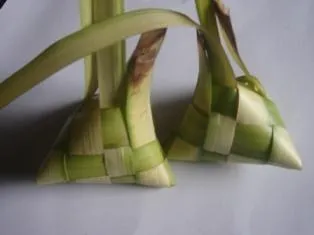Puso sa Lukay
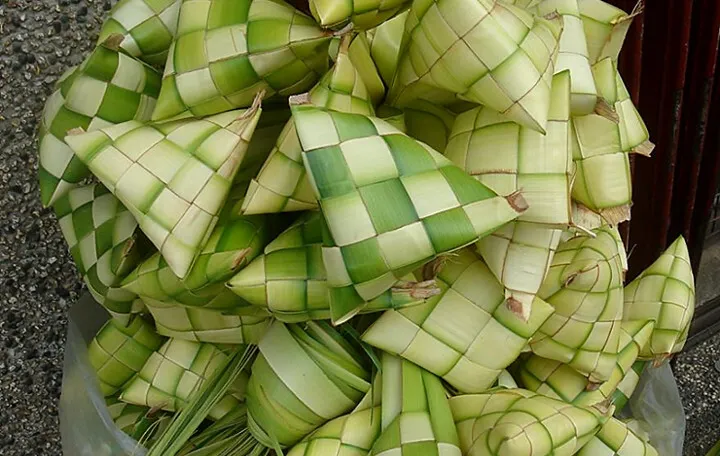
The heart of palm is the very life center of the coconut tree. It sprouts into a regal, straight, unopened yellow-green tendril called lukay in Cebu, uyok in Masbate, dugokan in Leyte, palaspas in Laguna, ugbos in Pangasinan, ebus in Kapampangan, and langkoy in Bikolano. These fresh and pliable coconut leaflets find their way into Filipino cooking, not necessarily as ingredient, but as ingenious and beautiful food packaging material.
With creativity borne out of necessity for packaging and transporting boiled food, particularly rice, lukay has been woven into distinctive shapes of pouches, which are generally called pusô. These heart-shaped rice pouches have regional attributes as well. It is called langbay, lambay, or linambay in Samar; piyoso in Lanao; piyusopusu in Mindoro; temu in Basilan; tamu in Jolo; tam-o in Aklan; suman in Tagalog; patupat in Pangasinan and Ilocos; and katumpat in Tawi-Tawi.
Fr. Mateo Sanchez, S.J. (1562-1618) in his early Samarnon-Lineyte Bisayan lexicon, Vocabulario de la Lengua Bisaya (1615-1617) noted that it was usually the women who made the poso (papamosoon co nin iton manga babaye) of various forms and sizes. Short of describing each one of them, he listed the names of the different kinds of pusô that came to his attention, indicating the wealth of samples of woven pouches. By looking at the meanings of these words, which were provided as separate entries in his vocabulario, one can envisage how these forms might have looked like.
Some names of pusô suggest parts of the human anatomy. (1) Cumol sin datu might have the size and round shape of a datu's cumo, or clenched fist. (2) Linalaqui was probably made for, or by, men and might have had the shape of the male genital. On the other hand, (3) binabaye was made for, or by, women and had the shape of the female genital or breast. (4) Sinaop had the shape of two hands clasped together created by two sets of coiled leaflets woven together, while (5) tinicod acquired the form of the foot, probably a triangular pyramid with a flat bottom.
Geometric shapes were also suggested by the other puso in the list. (6) Binitoon imitated the shape of a star, as (7) langbay, that is, linangbay or linambay, had the roundabout character of a lambay or crab. While (8) tambong was flat and rectangular like the tamales called tambon or tambol, (9) binairan was rectangular as a whetstone. (10) Bayobayo was long and cylindrical like a small pestle.
The other puso had more difficult shapes to imagine, as they copied images of plants and animals. (11) Bungan gapas was like the fruit of a kapok cotton tree that is, tapering on both ends and bulging in its midsection. (12) Binaobao was probably in the shape of an overturned carapace of a squash bug or turtle but smaller than (13) pinavican, which was in the form of a sea turtle's carapace. (14) Ynamo (or inamo) was quite difficult to imagine as it was in the form of an amo, or monkey, but probably round as a monkey's head.
The examples enumerated by the lexicographers should not pass unnoticed here. Efforts have been made to identify them with possible existing samples of pusô. A recent survey undertaken by the Cebu Normal University was able to identify seven samples of puso that are still commonly recognized in present-day Cebu Province: (1) kinasing (spinning top-like), (2) binaki (frog-like), (3) pudol (broken or blunt end), (4) binosa (wine glass-like), (5) badbaranay (to unravel), (6) manan-aw (phalaenopsis orchid), and (7) minanok (chicken-like). Some of these puso forms are still used as offertory victuals in thanksgiving rituals called hikayan, and in exorcism rituals called yamyam, both performed by male shamans called tambalan.
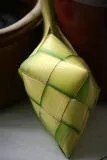
In the said survey, the most common form of puso is the kinasing (fig. 1), which resembles a diamond-shaped kasing or spinning top. Others equate this form to the shape of the heart or kasing-kasing. The kinasing is almost synonymous to puso as this is the most common rice pouch in Cebu, Glan, Camiguin, and Cagayan de Oro. It has the very pleasing shape of a tight conical diamond, thus it is called tinaligsok in Anda, Bohol. Recalling the shape of the banana heart blossom, the Sama Dilaut of Sitangkai, Tawi-Tawi, call it tungkal saging; the Tagbanuwa, piyusupusu; and in Palaw-anon, pinupuso. In Aklan this is called eaki tam-o, the masculine pusô, perhaps refering to the same linalaqui listed by Sanchez and the poso nga linalaque recorded by Mentrida, which he described as a rice pouch that was esquinado or with angular corners.

Binaki (fig. 2), together with kinasing, are the two most common shapes of pouches in barbeque joints in Cebu. The mamumuso or puso weavers in Taboan, Cebu City, compare its shape to a baki or squat frog. Similarly Palaw-anon recall the frog when they call it kongkang. The Mangyan of Mindoro turn a knot on its tip to create the illusion of a bird they call piyusopusu. For their part, the Sama Dilaut women compare it to their pillows called uwan-uwan. In Carcar, Cebu, some call it binaba as this could fill only a baba or a mouthful. Others call it sinayop, which means "to intentionally make a mistake." Probably they mean sinaop or the Bisayan word for being boiled. Thus, this might be similar to the sinaop of Fr. Mateo Sanchez, referring to the saop, pagsaopan ang camot, or hands clasped together like the two leaflets that are intertwined to make this form. Interestingly in Aklan, they call it bayi tam-o, the female pusô, perhaps similar to the binabaye of Father Sanchez.
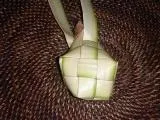
The other one is pudol (fig. 3), which is woven like a kinasing but with a blunt end of a tigib or chisel, thus called by its curious name of tinigib (chisel-like) in Barangay Binaliw in Talamban, Cebu City. However in Taptap, Cebu, they call it pudol or dumpol, again referring to its blunt end. Some puso weavers prefer weaving tinigib as it removes the complication of making the pointed corner in the kinasing. In Sitangkai, Tawi-Tawi, they call it buwah pagung, bringing to mind the shape of the fruit of the nipa palm. In a way, this could be the bungan gapas or the fruit of a kapok cotton tree mentioned by Father Sanchez.
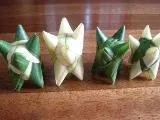
The smallest puso that they make in Taptap, Cebu, is called binosa (fig. 4), the shape of a small wine glass [the photograph says otherwise; or might another type be referred to by this description? please clarify]. They are usually offered in bunches of a dozen each and placed on round porcelain plates during hikayan thanksgiving ceremonies or yamyam healing rituals to exorcise the bad spirits called dili-ingon-nato. The farmers in Barangay Katipunan in Anda, Bohol, weave a similar puso from a single strip of coconut leaflet they call inumol the size of the clenched fist, which is another way of calling binosa when they consult a tambalan, or shaman, to perform a pagdiwata ritual before clearing a stretch of forestland, or start erecting the first post of their new house. They usually prepare temporary altars and offer the spirits with cigarettes, candles, coconut oil, and plates of boiled puso of various shapes and sizes.
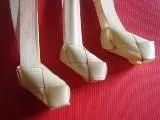
Kumo (fig. 5) is created by intertwining two loops to create a closed pouch as big as a clenched fist or kumo. In Pinabacdao, Western Samar, they make kumo small enough to contain a fistful of boiled rice. It is rarely seen in markets for sale. Bunched together in a dozen and placed on a round plate, they are used in offertory rituals. The construction uses two connected overhand loops that are made to intertwine each other. In Tanjay, Negros Oriental, they make these small rice pouches for sweet meats called bulasa (fig. 6), which are served during weddings and feasts. The Maranao call this form kimes a datu, or "lump of rice by the palm of the hand of the datu," or simply "fist of the datu." This pouch is small such that the boiled rice it contains is just enough for a mouthful. The Yakan use it to boil sticky rice cakes they call tamu lugus, recalling the shape of the areca nut bunched on a palm tree. The cumol sin datu of Father Sanchez could either be kumo, inumol, or bulasa.
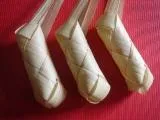
Less known in Cebu is badbaranay (fig. 7), which means to unravel, although it is better known by its other name of pinawikan (seaturtle-like) in Barangay Binaliw in Talamban, Cebu City. It is also the preferred shape in Dumaguete City, Bais, Tanjay, and Malatapay in Negros Oriental Province, and sometimes called by other names like pinagi (rayfish-like) or binalek (returned back) as the leaflets are turned back as they are woven through the pouch. Being made from four strips of leaflets instead of just two, it can accommodate more grains of rice than the familiar kinasing or binaki. This might be the poso nga pinaouican mentioned by Fr. Alonso de Mentrida or the pinavican of Fr. Sanchez.
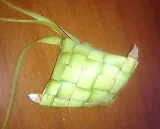
Manan-aw (fig. 8) is a lesser-known puso in Cebu. It is named after an orchid, Phalaenopsis amabilis, locally known as manan-aw. They hang the puso like these flowers on windowsills to be admired. Just like the beauty of the orchid, it is a fitting offering used during hikayan ceremonies. It is bigger than the pinawikan as it is made from eight strips of coconut leaflets and thus, a figure more challenging to make.
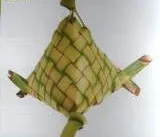
The other lesser-known puso; is minanok (fig. 9), which is woven in the shape of a hen in Taptap, Cebu City. They are used for making offerings during hikayan prayer rites. The Yakan make a similar form but with a difference in the rendering of the head and tail to imitate the shape of the kambing (goat) (fig. 10). It is tempting to suppose that this could have been used in earlier forms of rituals as the linangang bird or ginawig hen mentioned earlier by Father Alcina. These are probably one of the juguetes muy vistosos, or very pretty toys, noted by Alcina.
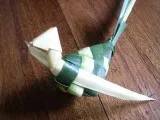
Another interesting shape of puso recently identified in Barangay Binaliw in Talamban, Cebu, is the binungi (fig. 11), which means "extracted tooth" since it looks like one. Unlike the other puso forms mentioned earlier, the binungi is not made as offertory victuals but rather simply to amuse.
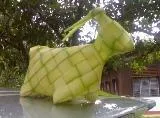
In Anda, Bohol, a tambalan priest prepares a lantayan offering platform with intricate-looking puso called binangkito (fig. 12). As its name indicates, it resembles an upturned bangko or low stool chair with four protruding legs. With a slight variation, this pouch is very similar to the tinumpei (fig. 13) of the Yakan. Although it may look like an elegant four-point star, its purpose is hardly decorative but practical. The Yakan call it tinumpei referring to the tumpei bag they hang on their backs to free their hands to do farm work. They use it as bigger rice pouches for long-distance travel to the mountain or the sea. With its interesting star shape, this might be the binitoon mentioned by Father Sanchez.
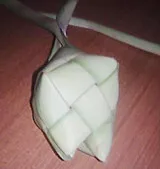
The Yakan compare this rice pouch to a long hellu or wooden pestle (fig. 14). This form is now rarely seen in Basilan and no longer used as a rice pouch. Only a remaining few older Yakan can remember how this form is woven. The hellu might be the bayubayo noted by Father Sanchez, which is like a small pestle that is round and long like a cylinder.
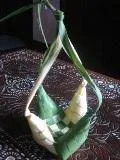
The pat bettes, or cow's hoofs (fig. 15), is one of the most commonly recognized rice pouches in Basilan. With the simple hurdle of making four corners for the pouch it creates the illusion of a foot sole or a cow's hoofs, thus its name. Probably this is similar to the pusu tinicod mentioned by Father Sanchez, which acquired the form of the sole of the foot, probably a triangular pyramid with a flat bottom.
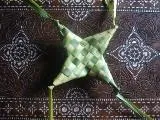
Another interesting rice pouch is the patupat (fig. 16), which is rectangular in shape. Because of this shape, the Maranao call it ulona a babak (pillow of the monkey). Unlike pusu, which is simply boiled in water, patupat is boiled in a vat of sugarcane juice, or molasses, and is usually eaten not with viands but as sweetmeats. It is popularly prepared in sugarcane-producing areas in the Ilocos, Pangasinan, and Cagayan. This rectangular rice pouch is rarely seen in the Visayas, but could it be the tambong (flat and rectangular like the tamales) or the binairan (rectangular whetstone) listed by Father Sanchez? It may also be the poso nga paholan mentioned by Father Mentrida, which took the shape of a small piece of wood fastened at the back of fisherman's waist.
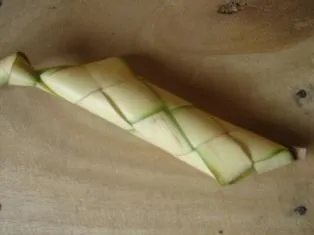
In Sitio Pinataray, Barangay Panitian, Espanola, in the island of Palawan, they make a rice pouch that is interestingly called pinagbutasan (fig. 17). This might be related to Alcina's poso that was used in the pagbutas ritual after burying the dead. However, the present-day Palaw-anon story is far removed from it and has a secular mode and romantic twist. They relate a story in the past of a datu who took a second wife and gave all signs that he loved her more than his first wife. When he cut a rice pouch into two and gave the bigger portion to his new wife, the old wife got angry and went into fits of jealousy. She decided that it was time for them to part ways (pagbutas) and considered the pusu as the cause of their separation, or pinagbutasan.
